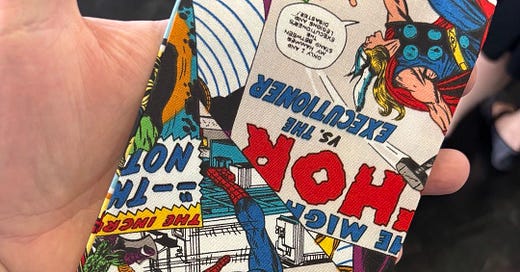I do my best to NOT identify as a pastor in public settings [more on that below]. But, lately, with the ongoing immigration raids, I have found that showing up to protests and vigils as “clergy” makes a difference.
How to Kill a Conversation with One Simple Question
Two gala dinners in four days, seated with mostly strangers who inevitably ask me, “What do you do?” At this point in my career, I know my answer is going to bring whatever lively conversation is happening to a halt. The ka-thunk of my answer like a dead weight in the middle of the table, “I pastor a church,” causes stomachs to drop. I want to qualify…
So, that means I wear a black shirt with a stole. I have normal ones, but my stole-of-choice is one I recently acquired featuring comic book covers from Marvel’s golden age. The other clergy I meet have their crosses and doves, royal purples or gold etching. Mine has Spider-Man facing off against Green Goblin, Daredevil overlooking a darkened New York City, and Black Panther punching Captain America in the jaw.
Stan Lee’s early Marvel heroes were often marginalized and overlooked. A teenage geek bit by a spider, a blind man, and an entire team of mutants who functioned as an allegory for racism and, later, homophobia. Even Captain America, an emblem of our country’s military-industrial complex, begins as a 4F reject unfit for service. Many of the Marvel heroes are rejected by the systems of power (think J. Jonah Jameson’s hatred for Spider-Man, and government leaders seeking to control or “cure” the X-Men). And yet, the marginalized people are the powerful ones, who know of the plight of their neighborhoods and seek to rescue them.
So, on Saturday night at a vigil in Pasadena following an immigration raid at a local park, I show up with my kids and my stole. And they are concerned about my choice. “Would you like me to explain the intersection of faith, ethics, and Marvel superheroes as it speaks to the climate of immigration in America?” I offer. They humor me for a couple of minutes. And I remember that I wrote a lengthy final paper for an ethics class in seminary, about the diversity of Marvel’s roster of heroes.
Ten years ago, Marvel celebrated “All-New, All-Different” heroes. Captain America was Sam Wilson, a Black man previously known as Falcon. Spider-Man was an Afro-Latino named Miles Morales and Ms. Marvel was Kamala Khan, a Pakistani teenager. Mjolnir wasn’t wielded by Thor Odinson, but Jane Foster. The paper explores a concept from Charles Taylor, how the tensions between differentiation and homogenization guide our relationships with others. We are the same, on one hand; and yet entirely different on the other. We should honor both realities.
Echoing Miroslav Volf’s idea of a “permeable boundary,” we should allow ourselves to be influenced by others’ stories while telling our own. This idea has lead me over the years to embrace a wider table and more open doors in my faith. I conclude in the paper:
When superhero stories reflect the diversity of our society, they encourage us to embrace new characters that add depth to the meaning of “hero.” And, I believe that the Christian story carries us further, envisioning a future horizon with tangible clarity – “all tribes and peoples and languages” (Revelation 7:9) praising the one who rescues and redeems humanity.
So, sure, the stole is silly, colorful, and “me.” But, for me, it represents new ways of thinking about others, especially those whose stories are too often disregarded and ignored. If we can center the marginalized in our thought and theology, we find a place for everyone.




